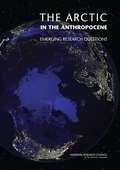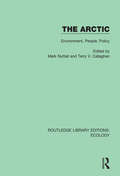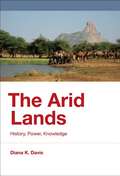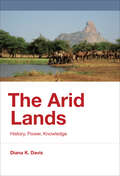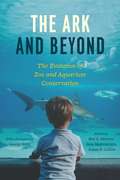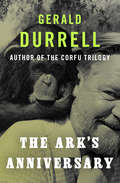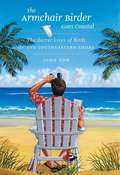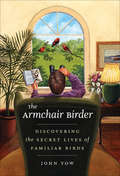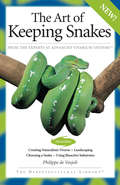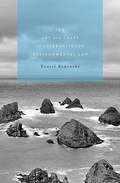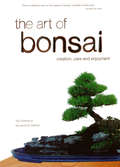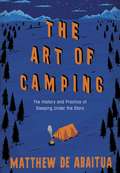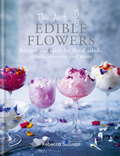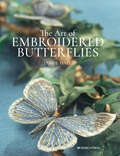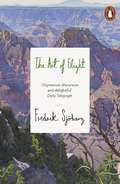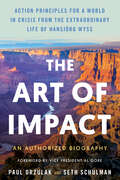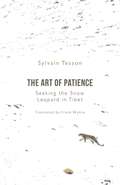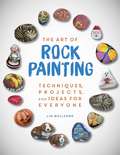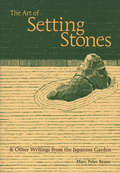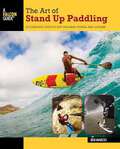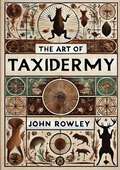- Table View
- List View
The Arctic in the Anthropocene: Emerging Research Questions
by Committee on Emerging Research Questions in the ArcticOnce ice-bound, difficult to access, and largely ignored by the rest of the world, the Arctic is now front and center in the midst of many important questions facing the world today. Our daily weather, what we eat, and coastal flooding are all interconnected with the future of the Arctic. The year 2012 was an astounding year for Arctic change. The summer sea ice volume smashed previous records, losing approximately 75 percent of its value since 1980 and half of its areal coverage. Multiple records were also broken when 97 percent of Greenland's surface experienced melt conditions in 2012, the largest melt extent in the satellite era. Receding ice caps in Arctic Canada are now exposing land surfaces that have been continuously ice covered for more than 40,000 years. What happens in the Arctic has far-reaching implications around the world. Loss of snow and ice exacerbates climate change and is the largest contributor to expected global sea level rise during the next century. Ten percent of the world's fish catches comes from Arctic and sub-Arctic waters. The U. S. Geological Survey estimated that up to 13 percent of the world's remaining oil reserves are in the Arctic. The geologic history of the Arctic may hold vital clues about massive volcanic eruptions and the consequent release of massive amount of coal fly ash that is thought to have caused mass extinctions in the distant past. How will these changes affect the rest of Earth? What research should we invest in to best understand this previously hidden land, manage impacts of change on Arctic communities, and cooperate with researchers from other nations? "The Arctic in the Anthropocene" reviews research questions previously identified by Arctic researchers, and then highlights the new questions that have emerged in the wake of and expectation of further rapid Arctic change, as well as new capabilities to address them. This report is meant to guide future directions in U. S. Arctic research so that research is targeted on critical scientific and societal questions and conducted as effectively as possible. "The Arctic in the Anthropocene" identifies both a disciplinary and a cross-cutting research strategy for the next 10 to 20 years, and evaluates infrastructure needs and collaboration opportunities. The climate, biology, and society in the Arctic are changing in rapid, complex, and interactive ways. Understanding the Arctic system has never been more critical; thus, Arctic research has never been more important. This report will be a resource for institutions, funders, policy makers, and students. Written in an engaging style, "The Arctic in the Anthropocene" paints a picture of one of the last unknown places on this planet, and communicates the excitement and importance of the discoveries and challenges that lie ahead.
The Arctic: Environment, People, Policy (Routledge Library Editions: Ecology #10)
by Mark Nuttall Terry V. CallaghanOriginally published in 2000, The Arctic provides a comprehensive overview of the region's rapidly changing physical and human dimensions, and demonstrates the importance of communication between natural scientists, social scientists, and local stakeholders in response to the tremendous challenges and opportunities facing the Arctic. It is an essential resource for all Arctic researchers, particularly those developing multidisciplinary projects. It provides an overview of key areas of Arctic research by renowned specialists in the field, and each chapter forms a detailed, varied and accessible account of current knowledge. Each author introduces the subject to a specialist readership, while retaining intellectual integrity and relevance for specialists. Overall, the richness of the material presented in this volume reflects the ecological and cultural diversity of this vast and environmentally critical part of the globe.
The Arid Lands: History, Power, Knowledge
by Diana K. DavisDeserts are commonly imagined as barren, defiled, worthless places, wastelands in need of development. This understanding has fueled extensive anti-desertification efforts -- a multimillion-dollar global campaign driven by perceptions of a looming crisis. In this book, Diana Davis argues that estimates of desertification have been significantly exaggerated and that deserts and drylands -- which constitute about 41% of the earth's landmass -- are actually resilient and biodiverse environments in which a great many indigenous people have long lived sustainably. Meanwhile, contemporary arid lands development programs and anti-desertification efforts have met with little success. As Davis explains, these environments are not governed by the equilibrium ecological dynamics that apply in most other regions. Davis shows that our notion of the arid lands as wastelands derives largely from politically motivated Anglo-European colonial assumptions that these regions had been laid waste by "traditional" uses of the land. Unfortunately, such assumptions still frequently inform policy. Drawing on political ecology and environmental history, Davis traces changes in our understanding of deserts, from the benign views of the classical era to Christian associations of the desert with sinful activities to later (neo)colonial assumptions of destruction. She further explains how our thinking about deserts is problematically related to our conceptions of forests and desiccation. Davis concludes that a new understanding of the arid lands as healthy, natural, but variable ecosystems that do not necessarily need improvement or development will facilitate a more sustainable future for the world's magnificent drylands.
The Arid Lands: History, Power, Knowledge (History for a Sustainable Future)
by Diana K. DavisAn argument that the perception of arid lands as wastelands is politically motivated and that these landscapes are variable, biodiverse ecosystems, whose inhabitants must be empowered. Deserts are commonly imagined as barren, defiled, worthless places, wastelands in need of development. This understanding has fueled extensive anti-desertification efforts—a multimillion-dollar global campaign driven by perceptions of a looming crisis. In this book, Diana Davis argues that estimates of desertification have been significantly exaggerated and that deserts and drylands—which constitute about 41% of the earth's landmass—are actually resilient and biodiverse environments in which a great many indigenous people have long lived sustainably. Meanwhile, contemporary arid lands development programs and anti-desertification efforts have met with little success. As Davis explains, these environments are not governed by the equilibrium ecological dynamics that apply in most other regions. Davis shows that our notion of the arid lands as wastelands derives largely from politically motivated Anglo-European colonial assumptions that these regions had been laid waste by “traditional” uses of the land. Unfortunately, such assumptions still frequently inform policy. Drawing on political ecology and environmental history, Davis traces changes in our understanding of deserts, from the benign views of the classical era to Christian associations of the desert with sinful activities to later (neo)colonial assumptions of destruction. She further explains how our thinking about deserts is problematically related to our conceptions of forests and desiccation. Davis concludes that a new understanding of the arid lands as healthy, natural, but variable ecosystems that do not necessarily need improvement or development will facilitate a more sustainable future for the world's magnificent drylands.
The Ark and Beyond: The Evolution of Zoo and Aquarium Conservation (Convening Science: Discovery At The Marine Biological Laboratory Ser.)
by Ben A. Minteer Jane Maienschein James P. CollinsScores of wild species and ecosystems around the world face a variety of human-caused threats, from habitat destruction and fragmentation to rapid climate change. But there is hope, and it, too, comes in a most human form: zoos and aquariums. Gathering a diverse, multi-institutional collection of leading zoo and aquarium scientists as well as historians, philosophers, biologists, and social scientists, The Ark and Beyond traces the history and underscores the present role of these organizations as essential conservation actors. It also offers a framework for their future course, reaffirming that if zoos and aquariums make biodiversity conservation a top priority, these institutions can play a vital role in tackling conservation challenges of global magnitude. While early menageries were anything but the centers of conservation that many zoos are today, a concern with wildlife preservation has been an integral component of the modern, professionally run zoo since the nineteenth century. From captive breeding initiatives to rewilding programs, zoos and aquariums have long been at the cutting edge of research and conservation science, sites of impressive new genetic and reproductive techniques. Today, their efforts reach even further beyond recreation, with educational programs, community-based conservation initiatives, and international, collaborative programs designed to combat species extinction and protect habitats at a range of scales. Addressing related topics as diverse as zoo animal welfare, species reintroductions, amphibian extinctions, and whether zoos can truly be “wild,” this book explores the whole range of research and conservation practices that spring from zoos and aquariums while emphasizing the historical, scientific, and ethical traditions that shape these efforts. Also featuring an inspiring foreword by the late George Rabb, president emeritus of the Chicago Zoological Society / Brookfield Zoo, The Ark and Beyond illuminates these institutions’ growing significance to the preservation of global biodiversity in this century.
The Ark's Anniversary (Windsor Ser.)
by Gerald DurrellThe conservationist whose work inspired Masterpiece production The Durrells in Corfu recounts the early years of the Durrell Wildlife Park. At the age of six, Gerald Durrell confidently told his mother he would one day have his own zoo. She told him it was a lovely idea and promptly forgot all about it. But the young naturalist&’s passion wasn&’t about to fade away any time soon. Written for the Durrell Wildlife Park&’s twenty-fifth anniversary, The Ark&’s Anniversary is the unconventional story of how one man&’s dream was transformed into the esteemed organization known today as the Durrell Wildlife Conservation Trust, dedicated to saving endangered species from extinction. In the beginning, everyone thought Durrell was crazy to place a zoo on the island of Jersey in the English Channel. But that didn&’t stop people from coming to see him and his menagerie of rare and exotic animals, including celebrities like Richard Adams, Princess Grace, David Niven (who presided over the wedding of two apes), and Princess Anne (who wrote the foreword to this book). The Ark&’s Anniversary is a delightful journey and a celebration of success for anyone who loves the natural world. This ebook features an illustrated biography of Gerald Durrell including rare photos from the author&’s estate.
The Armchair Birder Goes Coastal
by John YowWith his distinctively witty, anecdotal, and disarming voice, John Yow now journeys to the shore and shares his encounters with some of the most familiar and beloved coastal birds. Out of his travels--from North Carolina's Outer Banks, down the Atlantic coast, and westward along the Gulf of Mexico--come colorful accounts of twenty-eight species, from ubiquitous beach birds like sanderlings and laughing gulls to wonders of nature like roseate spoonbills and the American avocets. Along the way, Yow delves deeply into the birds' habits and behaviors, experiencing and relating the fascination that leads many an amateur naturalist to become the most unusual of species--a birder.Seasonally organized chapters explore the improbable, the wonderful, and the amusing aspects of these birds' lives. Yow embellishes his observations with field notes, anecdotes, and stories from some of America's finest naturalists--including John James Audubon, Arthur Cleveland Bent, Rachel Carson, and Peter Matthiessen. Combining the endless fascination of bird life with the pleasure of good reading, The Armchair Birder Goes Coastal is the perfect companion for any nature lover's next trip to the beach.
The Armchair Birder's Omnibus Ebook
by John YowAvailable for the first time together in this Omnibus E-Book, The Armchair Birder's Omnibus brings together both of John Yow's delightful books into one convenient e-book.While birding literature is filled with tales of expert observers spotting rare species in exotic locales, John Yow reminds us in The Armchair Birder, that the most fascinating birds can be the ones perched right outside our windows. In thirty-five engaging and sometimes irreverent vignettes, Yow reveals the fascinating lives of the birds we see nearly every day. Following the seasons, he covers forty-two species, discussing the improbable, unusual, and comical aspects of his subjects' lives. Yow offers his own observations, anecdotes, and stories as well as those of America's classic bird writers, such as John James Audubon, Arthur Bent, and Edward Forbush. This unique addition to bird literature combines the fascination of bird life with the pleasure of good reading.In his follow-up volume The Armchair Birder Goes Coastal, Yow now journeys to the shore and shares his encounters with some of the most familiar and beloved coastal birds. Out of his travels--from North Carolina's Outer Banks, down the Atlantic coast, and westward along the Gulf of Mexico--come colorful accounts of twenty-eight species, from ubiquitous beach birds like sanderlings and laughing gulls to wonders of nature like roseate spoonbills and the American avocets. Along the way, Yow delves deeply into the birds' habits and behaviors, experiencing and relating the fascination that leads many an amateur naturalist to become the most unusual of species--a birder.
The Armchair Birder: Discovering the Secret Lives of Familiar Birds
by John YowBird lovers, take heart! While the birding literature is filled with tales of expert observers spotting rare species in exotic locales, John Yow's The Armchair Birder reminds us that the most fascinating birds can be the ones perched right outside our windows. In thirty-five engaging, humorous, and even irreverent essays, Yow reveals the fascinating lives of birds you probably already recognize and naturally want to know more about--because they're the ones you see nearly every day. Following the seasons of the year, Yow covers forty-two species, from the Carolina wren that rings in the springtime to the sandhill crane croaking high overhead at the end of winter. Leisurely and entertaining, the essays explore the improbable, unusual, and comical aspects of their subjects' lives--from the philandering of the ruby-throated hummingbird to the occasional dipsomania of the cedar waxwing. Rather than bare facts and field marks, The Armchair Birder offers observations, anecdotes, and stories--not only Yow's own, but also those of America's classic bird writers, such as John James Audubon, Arthur Bent, and Edward Forbush, experts who saw it all and wrote with wit and passion. With The Armchair Birder, backyard birders will take new delight in the birds at their feeders, while veteran check-listers will enjoy putting their feet up. All will applaud this unique addition to bird literature, one that combines the fascination of bird life with the pleasure of good reading.
The Art Of Keeping Snakes
by Philippe De VosjoliFor author Philippe de Vosjoli, "art is the actualization of a personal vision or message," and de Vosjoli's passion is snakes, which he believes are among the most beautiful animals on earth. Incorporating snakes into a naturalistic vivarium, the way lizards and amphibians usually are, adds a new element to snake keeping, elevating the hobby to a true art form. In The Art of Keeping Snakes, de Vosjoli pursues this concept and provides advice for snake keepers who wish to create beautiful displays for their snakes, putting the animals' welfare and quality of life above all else and simultaneously enhancing their own enjoyment in observing their beautiful snakes in naturalistic environments. Beautifully photographed, inspiring, and informative, The Art of Keeping Snakes is divided into two parts, the first "A New Way to Keep Snakes," discusses design planning, enclosures and background possibilities, substrates, landscaping, plants, heating/lighting, quarantine and introducing the snakes to the vivarium. This part also includes chapters on feeding, handling, health care, and general maintenance and husbandry. The second part, "Best Display Snakes," presents over thirty different snakes, including photographs, physical descriptions, and tips for selection, handling, vivarium design tips, feeding, and breeding. The snakes in this part are divided into chapters, categorized by pythons, boas, water and garter snakes, hognose snakes, rat snakes, kingsnakes and milksnakes, and others. Resources and index included.
The Art and Craft of International Environmental Law
by Daniel BodanskyThe book focuses on the processes by which international environmental law is developed, implemented and enforced rather than on the substance of international environmental law itself-- already the subject of several excellent treatises. Process issues have received increased attention in recent years but have not yet received a book-length treatment. This work aims to fill that gap. Rather than focus on one or two aspects of the international environmental process, it examines the process as a whole, from beginning to end, synthesizing recent research on international environmental negotiations, treaty design, social norms, policy implementation and effectiveness. Understanding the international environmental process involves many disciplines--not only law, but also political science, economics, and, to a more limited degree, philosophy, sociology and anthropology. So this book is multidisciplinary. The aim is to provide the reader with the analytical tools necessary to understand what international environmental law is, how it operates, and what role it can play in addressing environmental problems.
The Art of Bonsai
by Giovanna M. Halford Yuji YoshimuraLearn the ins and outs of proper bonsai design and care with this comprehensive Japanese gardening book.Japanese bonsai have long been admired throughout the world while their care and preservation have seemed shrouded in mystery. The Art of Bonsai is, however, a comparatively simple art to learn. Anyone with a love a plants, a little patience and this eminently practical book can create bonsai and keep a finished plant healthy and vigorous for generations.Included in this definitive volume are:Detailed, illustrated instructions on propagation and trainingHints for those growing bonsai in a hurry and apartment dwellersDaily and seasonal bonsai care practicesDealing with pests and bonsai troubleshootingHow to judge, select and exhibit bonsaiDetailed appendices on tools, equipment, soil analysesData on more than 300 species of plants used in making bonsaiThis classic work remains an eminently practical book and is the classic guide to bonsai care. It contains the essentials of an art that is one of Japan's most treasured traditions--sculpting beauty in living wood.
The Art of Camping: The History and Practice of Sleeping Under the Stars
by Matthew De AbaituaCould there be another way of life? Can I survive with less stuff? Should I run for the hills?These are all good questions that people have asked before, throughout history, and which have inspired people to set up camp. But now camping is part of the drive for self-sufficiency, a reaction against mass tourism, a chance to connect with the land, to experience a community, to leave no trace . . . From packing to pitching, with hikes into the deep history of the subject and encounters with the great campers and camping movements of the past, this is the only book you'll need to pack when you next head off to sleep under the stars.IF THERE IS ONE THING THAT CAMPERS LIKE MORE THAN CAMPING, IT'S DREAMING ABOUT THEIR NEXT TRIP
The Art of Creative Pruning: Inventive Ideas for Training and Shaping Trees and Shrubs
by Jake HobsonNothing brings a touch of artistry to the garden like ornamental pruning, and a series of deliberate cuts can create landscapes and evoke faraway places. All that's needed to recreate the effect in the garden are a sharp pair of pruners, some imagination, and the instruction found in The Art of Creative Pruning. Drawing on both eastern and western styles, author Jake Hobson moves beyond the traditional lollipops and animals and teaches a wholly new approach to ornamental pruning that appeals to modern sensibilities. Picture boxwoods trimmed into whimsical Russian nesting dolls, hedges inscribed with words, and a tree snipped to resemble the toppling tiers of a wedding cake. These are just a few of the unusual ideas featured in the beautifully photographed pages. All the practical considerations are here as well, including pruning to improve a view, remedial pruning to fix problems, and pruning fruit trees to increase yield.
The Art of Edible Flowers: Recipes and ideas for floral salads, drinks, desserts and more (Art of series)
by Rebecca SullivanThis gorgeous little book is a joyful exploration of the many ways in which flowers can be used in a range of delicious recipes. From Rose and Lavender Cocktail Syrup to Jasmine and Green Tea Ice Cream, the ideas and flavours are subtly, deliciously floral. Savoury options include Courgette Carpaccio with Wood Sorrel Flowers and Artichokes with Roasted Garlic and Chive Flowers, while the drinks range from Fermented Elderflower Fizz to soothing Poppy Milk.Rebecca's creative ideas and thoughtful approach make the entire process of cooking a mindful experience, from picking the flowers through to the very last bite.Bursting with beautiful creations and infused with natural flavours, this volume offers recipes suitable for all abilities.
The Art of Embroidered Butterflies
by Jane E. HallWith gorgeous photos, a renowned textile artist guides you through the details of her creative process—and twelve amazing projects. The embroidery of Jane E. Hall is breathtaking, and in this book she combines her love of butterflies with her outstanding talent as a textile artist to produce three-dimensional renditions of exquisitely worked butterflies almost indistinguishable from the real thing.Using the finest of silk threads and needles, Jane lovingly creates her butterflies’ wings using the tiniest of stitches worked on to silk. They are then carefully cut away and the edges strengthened with hair-fine wire before being attached to the bodies, crafted from air-drying modelling medium and brushed with whisper-thin threads to resemble hairs. The butterflies are then placed within a setting of silk leaves and flowers, all made with the same painstaking attention to detail and expert skill as the butterflies themselves.This book provides a fascinating introduction to butterflies in nature, reflecting Jane’s love and admiration for these exquisite creatures, and goes on to describe the materials and methods Jane uses to produce her incredible creations. Twelve projects, each based on a different butterfly including the Painted Lady, Small Tortoiseshell, and Brimstone, present the finished piece along with the materials Jane used, and the photographs, swatches, drawings, and paintings that inspired it.
The Art of Flight
by Fredrik SjöbergAccidental Journeys with the Bestselling Author of The Fly TrapStories just begin. We rarely know where and almost never why. It doesn't matter. Nothing is certain any longer. I just want to shut my eyes, point at random and say, as a sort of experiment, that once, when I was sixteen years old, I spent a whole night singing romantic songs in the top of a pine tree. That's where it may have started.Fredrik Sjöberg continues his exploration of the pleasures and trials of those who spend their time tracing the smallest details of the natural world in these two tales of ambition, fear and hapless romance. Calling on his childhood memories and experience as a hoverfly collector, and following the trail of long forgotten entomologists before him who left their native Sweden for the national parks of the United States, Sjöberg contemplates the richness of life and the strange paths it leads us on.
The Art of Hutting: Live Off-Grid with The Highland Hutter
by Peter MacQueenLiving Off-the-Grid in ScotlandDon’t just experience Scottish history. Live it with The Art of Hutting, the essential beginner’s guide to sustainable living off the grid.Experience Scotland like never before. The Land of the Brave has so much to see and offer, but nothing is more breathtaking than living in its natural beauty. So how does one live away from the cities of Scotland? Inspired by traditional and modern shelter techniques, hutting expert Peter MacQueen shares how to live off the grid in The Art of Hutting. Each chapter answers many your questions about local sustainable living, from the safest bushcraft tools to growing a bountiful garden for every season. That way, you can be prepared to create your forever home and make memories in the untamed heart of Scotland.Create your own cozy Scottish hideaway. Along with learning the necessary outdoor skills to live off Scotland’s resources, this self-sufficient living book also shares how to create the hut of your dream. Off-grid living has never been cozier than with MacQueen’s hutting tips and tricks, from constructing the perfect eco-design to finding natural building materials. And with visual examples of local huts and cottages to choose from, you can create your next home with all the beauty and wonders the Scottish highlands and lowlands have to offer.Inside The Art of Hutting, you’ll also find:Best locations for hut buildingHow to create a wildlife garden made from Scotland’s natural vegetationRecommendations for fire-starter tools and firewood storageIf you liked books such as Thrive, Clansland Almanac, or Surviving the Wild, then you’ll love The Art of Hutting.
The Art of Impact: Action Principles for a World in Crisis from the Extraordinary Life of Hansjörg Wyss, An Authorized Biography
by Seth Schulman Paul Orzulak Vice President Al Gore"One of the most significant conservationists of our time—indeed, of all time." —Vice President Al Gore, from the Foreword He is the most impactful conservationist in the world, a man responsible for protecting more than one hundred million acres of land and more than three million square kilometers of ocean. Yet, chances are, you have never heard of him. HansjÖrg Wyss grew up in a working-class family in Switzerland. As a college student in the 1950s, he traveled to the United States for a summer job in Colorado. It was there that he first experienced the majesty of the Grand Canyon and the American West, which forever changed him. As a business leader, Wyss pioneered a medical device company that transformed orthopedic surgery to the benefit of both doctors and patients. It was in business that Wyss developed a groundbreaking approach to problem-solving to create maximum impact. When he sold his company, he became one of the wealthiest people in the world. Still, it was his reverence for America's natural wonders and open spaces that called him to do even more. Today, Wyss works to ensure that the lands, waters, and species of our planet are permanently protected for future generations to enjoy. Through the Wyss Foundation and his personal philanthropy, he also supports innovation to advance groundbreaking medical research, economic opportunity, democracy, women's health, education, and the arts. Wyss is living proof that we don't have to despair in the face of crisis. If we choose to act with courage, creativity, and focus, we can fight back and we can win. The Art of Impact tells the story of HansjÖrg Wyss through his greatest challenges and accomplishments, asking why he does what he does and what principles we can learn to find our own path to impact.
The Art of Migration: Birds, Insects, and the Changing Seasons in Chicagoland
by John Bates Peggy Macnamara James H. BooneTiny ruby-throated hummingbirds weighing less than a nickel fly from the upper Midwest to Costa Rica every fall, crossing the six-hundred-mile Gulf of Mexico without a single stop. One of the many creatures that commute on the Mississippi Flyway as part of an annual migration, they pass along Chicago’s lakefront and through midwestern backyards on a path used by their species for millennia. This magnificent migrational dance takes place every year in Chicagoland, yet it is often missed by the region’s two-legged residents. The Art of Migration uncovers these extraordinary patterns that play out over the seasons. Readers are introduced to over two hundred of the birds and insects that traverse regions from the edge of Lake Superior to Lake Michigan and to the rivers that flow into the Mississippi. As the only artist in residence at the Field Museum, Peggy Macnamara has a unique vantage point for studying these patterns and capturing their distinctive traits. Her magnificent watercolor illustrations capture flocks, movement, and species-specific details. The illustrations are accompanied by text from museum staff and include details such as natural histories, notable features for identification, behavior, and how species have adapted to environmental changes. The book follows a gentle seasonal sequence and includes chapters on studying migration, artist’s notes on illustrating wildlife, and tips on the best ways to watch for birds and insects in the Chicago area. A perfect balance of science and art, The Art of Migration will prompt us to marvel anew at the remarkable spectacle going on around us.
The Art of Patience: Seeking the Snow Leopard in Tibet
by Sylvain Tesson&‘The Art of Patience is extraordinarily beautiful, a narrative of prose that flows with poetry, a long last loving glance at the planet, a visit to the vital bedside of a living world determined to stay alive.&’ Carl Safina, author of Becoming Wild: How Animals Learn to be Animals The Art of Patience sees the renowned French adventurer and writer set off for the high plateaux of remotest Tibet in search of the elusive snow leopard. There, in the company of leading wildlife photographer Vincent Munier and two companions, at 5,000 metres and in temperatures of -25ºC, the team set up their hides on exposed mountainsides, and occasionally in the luxury of an icy cave, to await a visitation from the almost mythical beast. This tightly focused and tautly written narrative is simultaneously a dazzling account of an exacting journey, an apprenticeship in the art of patience, an acceptance of the ruthlessness of the natural world and, finally, a plea for ecological sanity. A small masterpiece, it is one of those books that demands to be read again and again.
The Art of Rock Painting: Techniques, Projects, and Ideas for Everyone
by Lin WellfordNew painters wanted! No experience is necessary with Lin Wellford’s instruction. Thousands have already discovered the thrill of turning rocks into works of art through Wellford’s easy-to-follow tips. Her bestselling books have helped to awaken interest in modern rock painting. The Art of Rock Painting offers a variety of easy projects designed to introduce basic painting techniques yet still appeal to seasoned painters. These projects include instructions to create: Butterflies Fruit Cats Dogs Flowers And more! Grab a brush, find a stone, and get ready to rock! Experience the magic of this fun and exciting art activity.
The Art of Setting Stones
by Marc Peter KeaneIn Japanese gardens, composition follows from placement of the first stone; all elements and plantings become interconnected. These eight essays on Kyoto gardens similarly begin with keen description and build into richly meditative excursions into art, Buddhism, nature, and science. Landscape architect Marc Keane shows how Japanese gardens are both a microcosm of the natural universe and a clear expression of our humanity, mirroring how we think, worship, and organize our lives and communities. Filled with passages of alluring beauty, this is a truly transcendent book about "experiencing" Japanese design.Marc Peter Keane has lived in Kyoto for 17 years and is author of Japanese Garden Design. He designs residential, company, and temple gardens.
The Art of Stand Up Paddling: A Complete Guide to SUP on Lakes, Rivers, and Oceans
by Ben MarcusStand up paddling (SUP) is experiencing fast growth in the United States and around the world. It can be enjoyed on inland lakes and rivers, as well as on the ocean and in the surf—but most important, it’s fun and a great way to stay fit. <p><p> The Art of Stand Up Paddling will include everything both new and not-so-new paddlers need to know—from buying a board and getting started on your local lake to paddling rivers and surfing ocean waves. This revised edition features a brand new chapter on SUP Yoga, which combines the passion of yoga with the art of stand up paddling. Also included is a fascinating and controversial history of stand up paddling, which, although new to many, dates back hundreds of years to Peruvian fishermen, Venetian gondoliers, and Hawaiian beach boys. Chapters on surf-break etiquette, fitness, yoga, and the exhilarating potential for adventures on a stand up paddleboard makes this a complete resource for beginners and experienced paddlers alike.
The Art of Taxidermy
by John Rowley"The Art of Taxidermy" by John Rowley is an authoritative and comprehensive guide to the fascinating world of taxidermy. Rowley, a master taxidermist with years of experience, offers readers an in-depth look into the techniques, tools, and artistry involved in preserving and mounting animals. This seminal work serves as both a practical manual for aspiring taxidermists and an insightful exploration of the history and evolution of this unique craft.Rowley begins by tracing the origins and development of taxidermy, providing a historical context that highlights its significance in scientific research, education, and art. He delves into the various methods used throughout the centuries, showcasing how taxidermy has evolved into a sophisticated and respected discipline.The heart of "The Art of Taxidermy" lies in its detailed instructions and step-by-step guides. Rowley covers a wide range of topics, from the basics of skinning and preserving specimens to the more advanced techniques of shaping, mounting, and creating lifelike displays. Each chapter is filled with practical tips, illustrative diagrams, and clear explanations, making the complex processes accessible to both beginners and experienced practitioners.In addition to the technical aspects, Rowley emphasizes the artistic side of taxidermy, discussing the importance of anatomical accuracy, natural poses, and realistic finishing touches. He provides insights into the creative process, encouraging readers to develop their own style and approach to this intricate art form."The Art of Taxidermy" also includes a section on ethical considerations and best practices, underscoring the importance of sustainability and respect for wildlife. Rowley's passion for the craft and commitment to ethical standards shine through in every chapter, making this book a valuable resource for anyone interested in the responsible practice of taxidermy.Whether you are a novice taxidermist looking to learn the basics or an experienced artist seeking to refine your skills, John Rowley's "The Art of Taxidermy" offers a wealth of knowledge and inspiration. It stands as a timeless reference in the field, celebrating the blend of science, skill, and artistry that defines the craft of taxidermy.
